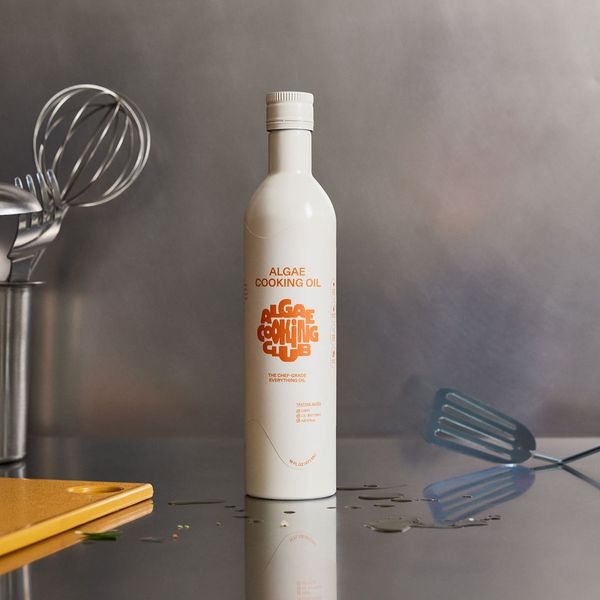
Fermentation is a fixture now in many restaurant kitchens with even modest ambitions with plenty of chefs making their own kimchee, turning grains and legumes other than the traditional soybean into misos, and cooking with koji (mold-inoculated rice or soybeans). The latest fermented food to sweep into grocery aisles and the kitchens of chefs like Daniel Humm is oil. I’ve seen Algae Cooking Club’s algae-derived oil on the shelves of Pop Up Grocer, and Zero Acre has partnered up with restaurants from Shake Shack to San Francisco’s Saison to feature its oil, which is made from fermented sugarcane. As a professional chef, I’ve been getting lots of targeted social-media ads for both. Both companies rely on chefs to market and demystify their products. Algae Cooking Club hit the market in February of this year, and Zero Acre launched its first product in late 2022.
These oils are made using abundant resources that require less energy and land to cultivate than those used for industrial vegetable or canola oil. Some vegetable oils, like palm oil, have been linked to a host of health problems as well as to deforestation and climate change. “Sugarcane is the highest-yielding crop in the world,” says Jeff Nobbs, the CEO of Zero Acre. The company uses non-GMO sugarcane, which is grown in, and processed into sugar, in Brazil and then fermented into oil. Zero Acre requires 87 percent less land to make its sugarcane oil than is used to produce the same amount of canola oil.
Algae Cooking Club’s oil is similarly made in a less resource-intensive way, but it comes from co-founder and CEO Kasra Saidi’s desire for a healthier alternative to the startling quantities of canola oil he was consuming through oat milk. He found one outside the food world. “About a quarter of skin care has algae in it,” he says. “Algae is big in the nutrition space but not in culinary. And we think it’s time for that moment to happen.”
And how exactly do you get oil through fermentation? Fermentation consultant and Fermentable owner Christine Syrad explained the process to me. When it comes to sugarcane, “Yeast behaves in a similar way to when wine is made. It has simply been selected to convert sugar to fat, not alcohol. The fermentation process is what yields the oil.” And in the case of microalgae, which makes Algae Cooking Club’s oil, these organisms “naturally convert sugar to oil and store it in their cells,” and we can then extract it.
I spent a weekend cooking every meal I consumed with both oils. They don’t smell like much. Sipping spoonfuls of the oils plain — the things I do in the name of science — I detected faint notes of butter or nuts. They’re lighter and less viscous than your average canola oil. Unlike other traditional non-seed oils (like olive oil, ghee, walnut oil, or coconut oil), they are almost flavorless. “We’re focused on trying to create a new category of oil,” says Nobbs. “It isn’t trying to mimic lard, other animal products, or vegetable oil.” They have extremely high smoke points, up to 485 degrees Fahrenheit, so they’re ideal for frying. In contrast, grape-seed oil’s smoke point is 421 degrees Fahrenheit. I tested out their abilities to fry at high temperatures by filling a small Dutch oven with each on my induction burner (which gets hotter at a faster rate than my gas stove). I aimed my portable countertop exhaust hood at the setup to avoid setting off my smoke alarm.
Using both oils separately, I fried falafel and arancini with remarkably crisp exteriors. Pan-frying eggs with them renders delicious, crunchy edges. They emulsify beautifully for homemade mayonnaise, vinaigrette, or toum. Unlike coconut oil, they remain liquid in the fridge. They can also be used in baking or for infused oils, when you want the flavor of an herb to shine rather than that of the oil. If you’re looking for a finishing oil or a punchy, spicy oil to whip into hummus, these aren’t it. But I know I’ll be using them for sautéing and frying on high heat, especially if I want my croquettes shatteringly crisp and my halloumi to emerge from my pan with lacy edges.
The Strategist is designed to surface the most useful, expert recommendations for things to buy across the vast e-commerce landscape. Some of our latest conquests include the best acne treatments, rolling luggage, pillows for side sleepers, natural anxiety remedies, and bath towels. We update links when possible, but note that deals can expire and all prices are subject to change.








